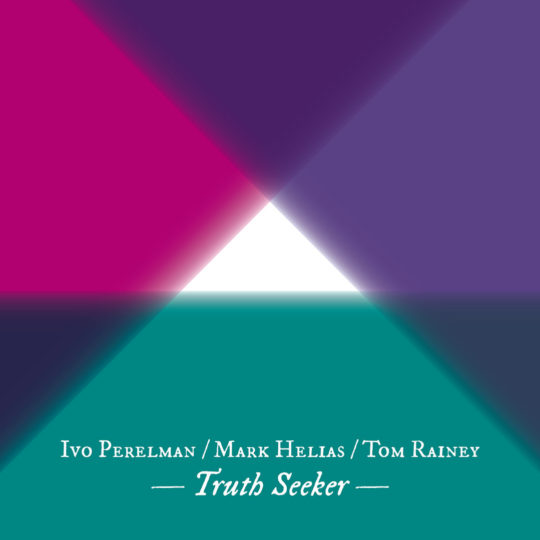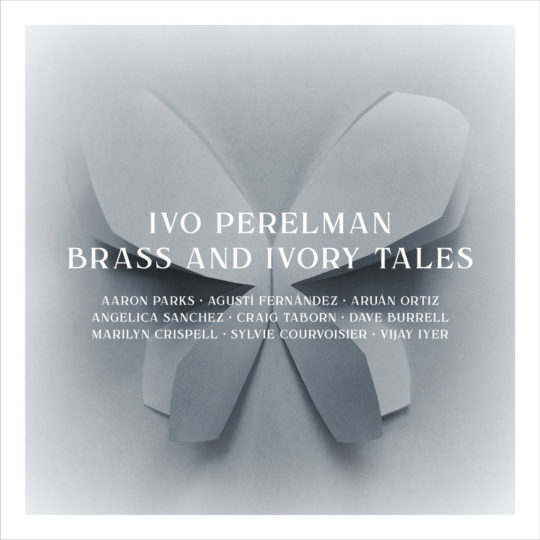You can go to any track on Truth Seeker to underscore the central premise of this album, but let’s start with the one titled “Devotion.” Whale-song moans from Mark Helias’s bass, added to Tom Rainey’s slow rat-a-tat at the drums, create a framework with middle-eastern overtones — a distant descendant, perhaps, of the exotica that has permeated jazz since Sidney Bechet’s “La Petite Fleur” and the Ellington band’s “Caravan.” Above this, saxophonist Ivo Perelman croons a brooding but rhapsodic melody in the tenor’s plummy lower register; at around 2:45, he discovers a series of phrases that should invite some wordsmith to write actual lyrics. After some fervid invention of the sort we expect from Perelman, the piece ends in an extended cadenza. It’s a pas de un rich in melody and measured in approach — a contemplative twirl in a spot of light on an otherwise darkened stage.
Or try the title track. It opens with a linear statement, compact and concise, of the sort we rarely expect from Perelman. From that theme he selects one motif, which he kneads until it plateaus at a new melody (1:30). He uses that plateau as a base camp for an ascent up the scale. He arrives at a skipping figure (2:05), which he sequences, with increasing force, until the entire trio reaches its peak (3:30) — after which Helias, in a post-climactic spotlight, stands alone, ready to provide the next full-bodied melody, and setting the scene for Perelman’s operatic return.
I love the frivolity that characterizes the opening moments of “Intuition”; the extended drums introduction to “Ubiquitous Light”; the deep resonances of “Life’s Meaning,” where Perelman weds his lower-register melody to the bowed bass line. On “Mystical Vibration,” I’m particularly drawn to the martial phrase that pops up around 2:26 and at 2:45, and even more to its reprise and subsequent development at 3:07 — one of countless moments that illustrate a lesson from the legendary Chicago tenor mentor Fred Anderson, who once told me, “If you listen to what you just played, you know what to play next.”)
These instances reveal a turning point in the wholly improvised performances that Perelman has purveyed for decades — a juncture marked by heightened structural clarity and a dazzling lyricism. It’s not the lyricism of Lester Young or Stan Getz, or John Coltrane playing ballads or Sonny Rollins at his most introspective. In fact, some listeners may not hear these melodies as “lyrical” at all: even at his most accessible, Perelman doesn’t follow convention. But such passages herald a revised melodic approach for this wildly prolific saxophonist.
Sequencing, thematic reprise and variation, long-lined melodies that unfold like highways (rather than steeplechase peaks and valleys) — all of these have belonged to jazz since it emerged more than a century ago. For Perelman, though, these techniques and stratagems have rarely if ever formed part of his game plan.
Then again, his game plan never included the MC Gregory mouthpiece that he acquired just a few years ago.
Can a mouthpiece really have that kind of impact? Can it influence not only the sound but also the content — the contextual and even philosophic underpinnings of the music?
“This new mouthpiece directs me naturally toward a mode of expression where each note occupies more weight, more gravity, than before,” Perelman marvels. “Before, my soul was ahead of the musical ideas, which would just come flying out. But this mouthpiece puts a brake on that a little. It lets me focus more on this note or that phrase. We’ve found together a nice niche.”
Even so, Perelman can’t assign full credit to the MC Gregory. “It’s not like I’m a completely new musician,” he emphasizes. “I am just reacting spontaneously to a different piece of equipment, which is nudging me to a parameter of my playing that was always there . . . It talks to people more, as if I’m articulating my thoughts in clearer, more digestible bits.” True enough: Perelman’s music began evolving in this direction as far back as 2018, on his duo album Amalgam, about which he explained, “We play less now and say more. . . . [E]ach note breathes because of the space around it.” So the change in gear has primarily catalyzed this maturation.
Throughout Truth Seeker, bassist Helias and percussionist Rainey do far more than accompany the saxophonist on this next leg of his search. They agree and they banter; they prod as well as support. Both take an exceptionally compositional approach to their specific instruments and to free improvisation in general. They refute the idea that such music needs to ignore all manner of form and structure; Truth Seeker pivots in large part on their attunement to the larger arc of each piece.
As Perelman notes, “They articulate their ideas very clearly. Every attack is heard. And they understand 4-bar, 8-bar, and 16-bar phrases; they understand the role of accompanists, and also when they have to take the lead or when to counterpose the soloist. So every moment, you have this feeling of mobility . . . this feeling of extreme beauty and balance.”
Now, about that mouthpiece . . .
A few years back, Perelman broke the mouthpiece that had served him well for the past 25 years. The mouthpiece is a vitally personal piece of equipment, essential to shaping timbre and attack, dynamics and vibrato. Losing a treasured mouthpiece? A catastrophe. (Perelman remembers his immediate reaction: “I’ll never play again!”) What’s more, the shattered mouthpiece was a 1950s Otto Link Slant Signature, a long-discontinued but revered model, prized by saxophonists as stylistically diverse as Getz and Coltrane, because of its potential for individual expression
Perelman located some same-vintage Otto Links on the resale market, but none of them matched up. (Miniscule variances ensure that no two mouthpieces are exactly alike.) He then turned to another well-regarded though lesser-known manufacturer, MC Gregory, and sampled more than a dozen mouthpieces before finding a winner. “This one particularly stood out,” he explains. “It seems to force me in a Paul Desmond direction, more contained, more directed, focused — more concentrated musical thought, with less fat.”
(Not coincidentally, alto saxist Desmond also used an MC Gregory, during and beyond his years with Dave Brubeck. And while it strains the imagination to place Desmond’s cool, dry impressionism in the same sentence with Perelman’s flamboyant hyper-expressionism, the fact remains that as a young saxophonist, Perelman idolized Desmond’s dreamy melodicism.)
Perelman’s last several albums trace this rediscovered restraint. Truth Seeker follows directly in the wake of Water Music, which presents the most convincing manifesto to date for the saxophonist’s change of direction — an album sure to become required listening for those who follow Perelman’s career. (Considering his discography runs to more than 125 recordings, that’s saying a lot.) The quartet on Water Music features his longtime soulmate, pianist Matthew Shipp — “the other half of [his] heartbeat,” to borrow Dizzy Gillespie’s description of Charlie Parker — along with Helias and Rainey. Perelman has long admired both, and finding them available, he jumped at the chance to work with them. The album they made will become required listening for future students of Perelman’s music.
Based on the quality of Water Music, Perelman decided to record again a couple weeks later, but this time with just Helias and Rainey. “I wanted to see how it would sound once we removed the strong personality that is Matthew,” he explains, which is hardly surprising. Perelman has spent his career mixing and matching artists and instruments, adding here or subtracting there, to challenge himself and his audience and to freshen his creativity.
The absence of Shipp’s piano does make for a more freewheeling and transparent conversation. But rather than diminish Perelman’s “new constraint,” this format redirects that concept. Truth Seeker has a more equitable distribution of the players’ roles, which makes it less a matter of a “Perelman quartet” and more a showcase for the Perelman-Helias-Rainey Trio. This is not because Helias and Rainey hog the limelight with stand-alone solos — they do not — but because their presence and contributions have so much to do with the emerging shape of each piece.
This music is also shaped by Perelman’s new emphasis on melody and space, which he sees as the next logical step. “After all, where else could I go? How could I add even more notes?” her asks. “Instead, I’m taking them out, to be more expressive, more eloquent.” Biofeedback plays a role as well: the mouthpiece produces different timbres and effects, and what he hears encourages the further distillation of his lines and ideas. You’ll hear this in the tenor’s lowest notes, which Perelman burnishes and lingers over, “because I’m savoring each note.”
But you hear it too in his vaunted control of the altissimo notes, high above the instrument’s written range, which now have even greater body and definition. At first listen, it appears that he makes less use of this register than usual, but Perelman says otherwise: “No, I’m playing just as many altissimo notes as before, and just as high. But this mouthpiece unifies all registers, even the extreme high ones, with a more homogenous character of sound. So if you have the impression that I’m playing less of the crazy high stuff, it’s because these notes are even better integrated in the overall sound quality.” They too sing with magnified focus and resonant sheen.
Each new recording by Perelman presents a search for artistic truths. Each does so in its own way. Here he maps a territory he has rarely visited in decades, with the aid of two master collaborators, one piece of hard rubber, and the time-honored realization that in order to say more, one sometimes has to say less.
NEIL TESSER
Tracklist
Details
Ivo Perelman, ivomusic (ASCAP)
Mark Helias, Radio Legs Music(BMI GEMA)
Tom Rainey, Rhydm Bidness (BMI)
Recorded, mixed and mastered by Jim Clouse, Parkwest Studios on December 2022
Ivo Perelman photo: Celso Oliveira
Mark Helias photo: Jordan Heminway
Tom Rainey photo: unknown
Graphic Design: SEMAFOR
Executive Producer: Maciej Karłowski




